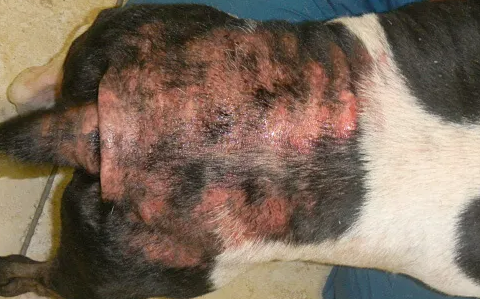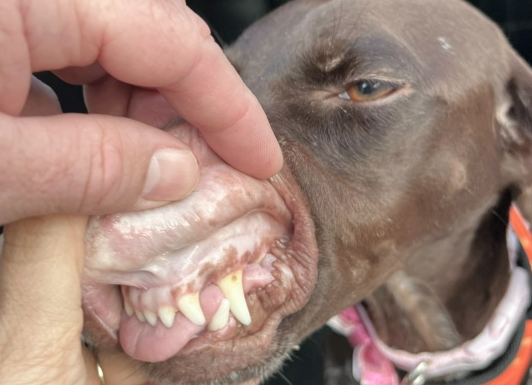Introduction: The Severity of Flea Infestations in Dogs
Identifying Fatal Flea Symptoms in Dogs. Welcome to our comprehensive guide on a critical issue for pet owners: flea infestation in dogs. Fleas, tiny as they may seem, pose a significant threat to your furry friend’s health. Recognizing the early signs of a potential life-threatening situation is not just important—it’s crucial. In this article, we delve into how these minute pests can endanger your dog’s life and why prompt action is paramount. …Click Here for more interesting Flea Articles!
Fleas are more than just a nuisance. They are blood-feeding parasites that can cause severe discomfort and health issues in dogs. An unchecked flea infestation can lead to serious complications, including anemia and, in extreme cases, death. Understanding the symptoms and knowing when to intervene can make all the difference.
We stand committed to educating and aiding you in this fight against fleas. With reliable information and actionable advice, you’ll be well-equipped to protect your beloved pet. For a deeper understanding of how fleas impact your dog’s health, visit the American Kennel Club’s comprehensive guide on flea infestation here.
Stay with us as we explore the signs of flea infestation and what you can do to ensure your dog’s safety and well-being. Together, we can tackle this challenge and keep our canine companions healthy and happy.
Understanding Fleas: The Culprits Behind the Danger
In this section, we’ll uncover the essentials about fleas, the tiny enemies of your dog’s health. Understanding these pests is the first step in combating them effectively.
What are Fleas?
Fleas are small, wingless insects that thrive on the blood of mammals, including our canine friends. They are known for their rapid reproduction and their ability to jump long distances, making them formidable invaders of your pet’s coat and your home.
How Fleas Infest and Affect Dogs
A single flea can turn into a full-blown infestation in no time. These parasites latch onto your dog’s skin, causing irritation, discomfort, and potentially more severe health issues. They are not just surface annoyances; their presence can lead to a range of problems, from allergic reactions to serious diseases.
The Potential Severity of Flea Infestations
The impact of fleas on dogs can be more than just physical discomfort. Heavy infestations can lead to anemia, especially in puppies and smaller breeds, due to the loss of blood. Furthermore, fleas can transmit other parasites, like tapeworms, and diseases, making their control a critical aspect of pet care.
For a deeper dive into the biology of fleas and their impact on pets, the Centers for Disease Control and Prevention (CDC) offers an insightful resource, which can be accessed here.
Gaining a thorough understanding of these pests is essential. As we progress, keep in mind that knowledge is power in the battle against flea infestations. Stay informed, stay vigilant, and keep your furry friends safe.
Primary Symptoms: Identifying the Signs of Danger
In this crucial section, we delve into the primary symptoms of flea infestation in dogs, a vital aspect for any dog owner to understand. Identifying these signs promptly can be the difference between a quick recovery and a life-threatening situation.
Excessive Scratching and Biting: The First Indicators
One of the earliest signs of flea activity is your dog’s increased scratching and biting. This behavior is a direct response to the irritation caused by flea bites. If you notice your dog is more restless than usual and constantly nibbling at its fur, it’s time to inspect closer for fleas.

Skin Lesions and Hair Loss: Visible Physical Symptoms
Flea bites can cause severe skin irritation, leading to lesions and hair loss in dogs. These areas often appear red, swollen, and may have scabs. Regular grooming and close examination of your dog’s coat can help you spot these signs early on.
Changes in Behavior: Lethargy, Irritability, and Decreased Appetite
Beyond the physical signs, fleas can affect your dog’s overall behavior. Watch for signs of lethargy, irritability, and a decrease in appetite. These behavioral changes, often overlooked, can indicate your dog is under stress from a flea infestation.
For more detailed information on the signs and symptoms of flea infestations in dogs, the PetMD website offers a comprehensive guide, accessible here.
Recognizing these symptoms early is key in providing prompt and effective treatment. As we continue, remember that your vigilance can safeguard your dog’s health and ensure they remain happy and comfortable.
Secondary Complications: When the Situation Worsens
In this segment, we focus on the secondary complications arising from flea infestations in dogs. Recognizing these advanced signs is crucial as they indicate a worsening condition that demands immediate attention.
Anemia in Dogs: Recognizing Pale Gums and Weakness

A serious concern with heavy flea infestation is anemia, especially in puppies or smaller dogs. This condition arises from significant blood loss. Symptoms include pale gums and general weakness. If your dog shows these signs, it’s a clear indication that the flea problem is severe and requires urgent veterinary care.
Flea Allergy Dermatitis (FAD): Severe Allergic Reactions
Some dogs are highly allergic to flea saliva, resulting in Flea Allergy Dermatitis (FAD). This condition leads to intense itching, skin inflammation, and even secondary skin infections. Look out for areas with severe redness or loss of hair, and consult your vet if these symptoms are present.
Risk of Tapeworms and Other Diseases Transmitted by Fleas
Fleas can be carriers of other parasites and diseases, such as tapeworms. Dogs can become infected with tapeworms if they ingest fleas during grooming. Be mindful of symptoms like weight loss, visible segments of tapeworms near the dog’s rear, or in its feces.
For an in-depth understanding of these secondary complications, the Merck Veterinary Manual provides valuable insights, available here.
The presence of these secondary symptoms often signals a critical stage of infestation. Timely intervention and proper veterinary care are imperative to prevent further deterioration of your dog’s health. Stay alert to these signs to ensure your pet remains safe and healthy.
Emergency Measures: Immediate Actions to Save Your Dog
As we progress to this essential section, we focus on the emergency measures required when a dog is suffering from a severe flea infestation. Understanding when and how to act can be life-saving for your pet.
When to Seek Veterinary Help: Understanding the Urgency
If your dog shows any severe symptoms of flea infestation, such as persistent scratching, skin lesions, lethargy, or signs of anemia, it’s time to seek immediate veterinary assistance. Early professional intervention can prevent the situation from escalating into a life-threatening emergency.
First-Aid Measures: What You Can Do at Home
While professional help is paramount, there are steps you can take at home to alleviate your dog’s discomfort. Start with a thorough bath using a vet-approved flea shampoo. Gently comb your dog’s fur with a flea comb to remove fleas and flea dirt. Remember, these are interim measures until you can get professional treatment.
Importance of Prompt and Professional Flea Treatment
Effective flea control involves more than just treating your dog; it includes addressing the environment to prevent re-infestation. Veterinarians can provide flea treatment products that are safe and effective, and also advise on cleaning your home and surroundings to eliminate flea eggs and larvae.
For a detailed guide on emergency flea treatment and home care tips, visit the ASPCA’s resource page here.
Prompt action in response to severe flea infestations is critical. By understanding the urgency and taking immediate steps, you can help ensure your dog’s swift recovery and long-term health. Remember, the quicker you act, the better the chances of your dog’s complete recovery from a flea infestation.
Prevention and Long-Term Care: Safeguarding Your Dog’s Health
Moving to the next critical stage, we address prevention and long-term care, vital components in safeguarding your dog’s health against flea infestations. Proactive measures not only protect your pet but also maintain a healthy environment for everyone at home.
Regular Flea Prevention Strategies
Consistency is key in flea prevention. Monthly topical treatments, oral medications, or flea collars are effective ways to keep fleas at bay. Consult your vet to choose the best preventive product for your dog. Additionally, regular baths and grooming help monitor and maintain your dog’s flea-free condition.
Maintaining a Flea-Free Environment
A flea-free home complements your dog’s personal flea prevention regimen. Regular vacuuming, especially in areas where your pet spends most of its time, is crucial. Wash your pet’s bedding, your bedding, and any fabric covers in hot water regularly to kill flea eggs and larvae.
Ongoing Health Monitoring and Veterinary Check-Ups
Routine health check-ups play a significant role in preventing flea-related health issues. Regular veterinary visits allow for early detection and treatment of any flea infestation. Keep an eye on your dog for any signs of discomfort or unusual behavior, and address these concerns with your vet promptly.
For comprehensive guidelines on flea prevention and environmental control, the American Society for the Prevention of Cruelty to Animals (ASPCA) offers a valuable resource, accessible here.
Prevention is undoubtedly better than cure when it comes to flea infestations. By implementing these strategies, you can ensure the well-being of your dog and maintain a healthy, flea-free home. Remember, your diligence in preventive measures is the best defense against flea-related issues.
Conclusion: The Role of Vigilance in Protecting Your Pet
As we conclude this comprehensive guide, let’s reflect on the importance of vigilance in protecting your pet from flea infestations. Being proactive and informed is essential in ensuring the health and happiness of your canine companion.
Summarizing the Importance of Early Detection and Treatment
Early detection and treatment of flea infestations are crucial. Recognizing the signs of fleas and taking immediate action can prevent more severe health issues. Regular check-ups and being attentive to changes in your dog’s behavior or appearance can make a significant difference.
Encouraging Responsible Pet Ownership
Responsible pet ownership extends beyond feeding and walking your dog. It includes safeguarding their health against parasites like fleas. Staying informed about flea prevention, understanding the risks, and acting promptly are all parts of being a responsible pet owner.
Invitation for Readers to Share Their Experiences and Seek Advice
Your experiences and insights are invaluable to us and our community. We invite you to share your stories and questions about dealing with flea infestations. Let’s build a supportive community where we can all learn from each other and provide the best care for our pets.
For additional support and resources, the American Veterinary Medical Association offers helpful information and guidance, available here.
In closing, remember that your awareness and action play a pivotal role in your dog’s health. Flea infestations are preventable and manageable with the right approach. Together, we can ensure our beloved pets lead a happy, healthy, and flea-free life.